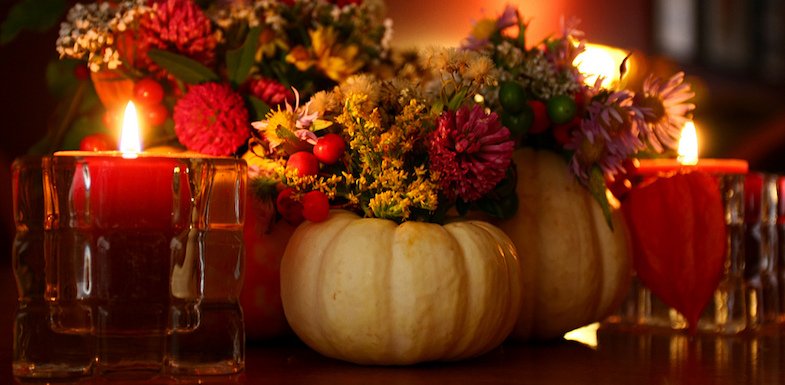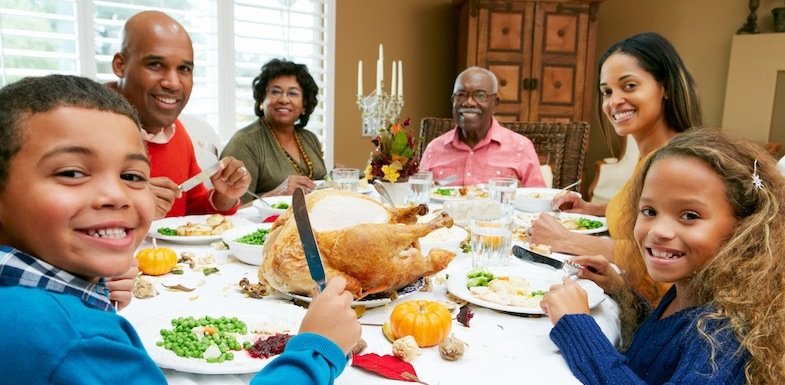
It’s the time of year when we’re supposed to remember what we’re thankful for, but sometimes it’s difficult to find things to be truly thankful for. Maybe you’ve got a chronic pain condition that resists treatment, or perhaps you’ve got a difficult home or work life. Whatever’s going on in your life, though, don’t let it block out the good things. Here’s how to make for a better Thanksgiving this year.
Towards gratitude
Living a grateful life can make you happier and healthier.
Lots of people go around the Thanksgiving table and say what they’re grateful for. This is a great tradition, but this year consider using Thanksgiving as a starting point for a more grateful lifestyle in general. Some research suggests that showing your gratitude can increase your level of happiness by as much as 25%.
The Change Blog explains why this can be beneficial for you:
“This is significant, among other things, because just as there’s a certain weight that feels natural to your body and which your body strives to maintain, your basic level of happiness is set at a predetermined point. If something bad happens to you during the day, your happiness can drop momentarily, but then it returns to its natural set-point. Likewise, if something positive happens to you, your level of happiness rises, and then it returns once again to your “happiness set-point”. A practice of gratitude raises your ‘happiness set-point’ so you can remain at a higher level of happiness regardless of outside circumstances.”
Gratitude in your daily life can make your relationships stronger, improve your health, and make you generally happier. Being grateful can also put things in perspective by reminding you of the good things in your life. People who are more grateful in general are more likely to make progress toward goals and maintain a healthy lifestyle, too.
Share gratitude
Share the gratitude with your family and friends.
Having a strong support network of loved ones can make life easier, so make sure you tell the people you care about how much you appreciate them. Expressing your gratitude and appreciation will make your friends and family happy, make you happy, and strengthen your bond.
In fact, in a 2011 New York Times article, University of Miami researcher Dr. Michael E. McCullough even stated that, “More than any other emotion, gratitude is the emotion of friendship.”
So this Thanksgiving, when you’re sharing what you’re grateful for around the table, include your loved ones in the list. Tell your family and friends exactly why you’re glad they’re in your life. If someone you care about isn’t at your table, call them or send them a message. Give genuine, specific compliments. If someone returns the favor, accept the compliment instead of brushing it off.
The beginning of Thanksgiving
Early Thanksgiving feasts likely featured Native American dishes, and not turkey, historians say.
The Thanksgiving feasts we know today, complete with turkey, cranberry sauce, and pumpkin pie probably do not resemble the first celebration, according to the History Channel. The Pilgrims had no oven to cook with and their sugar supplies were low, along with other food staples.
The meal was more likely inspired by Native American cuisine, particularly since the Pilgrim’s tribal allies had saved them from starvation by teaching the early settlers how to grow corn, capture maple tree sap, and fish in surrounding rivers.
Even before Thanksgiving was designated a specific calendar date, various U.S. presidents had issued proclamations for days spent giving gratitude. In 1789, George Washington called for a day of thanks, urging U.S. citizens to contemplate their gratefulness for the country’s independence from Britain. The day was infused with religious spirit, and Washington’s declaration encouraged citizens to give thanks to God.
Thanksgiving origins
Thanksgiving was originally intended as a religious day of thanking the Lord.
Over the years, the meaning of Thanksgiving has twisted and turned, taking on less religious significance. Today, it centers on eating and gathering with family, according to the History Channel. And of course, Thanksgiving is also inextricably tied to Christmas with the advent of Black Friday, with retailers offering deep discounts in hopes of kicking off the holiday shopping season with a bang.
One of Thanksgiving’s early links with shopping came during the Great Depression, when then-President Franklin D. Roosevelt changed the date of Thanksgiving, moving it up one week to encourage people to buy things and stimulate the economy, according to the History Channel. People opposed the change, and under pressure, Roosevelt switched Thanksgiving back to its original day, on the last Thursday in November.
Today, many people eat meals and then immediately go shopping for Black Friday. Stores used to open early Friday morning, but stores are now opening as early as 5 p.m. on Thanksgiving Day, reports the Huffington Post.
With people eager to start Christmas shopping and take advantage of sales, the gratitude component of Thanksgiving sometimes gets lost. However, taking time to express gratitude has been associated with improved health, both mental and physical, reports Time magazine.
Towards a better Thanksgiving
Instead of the typical Thanksgiving tradition of just saying what you’re thankful for, consider doing something more visual this year.
Writing down or displaying what you’re grateful for can force you to think of things beyond food or shelter. It can also serve as a reminder year to year or during difficult times. One option is to have a white tablecloth, with pens or markers at the table. Write what you’re grateful for and have your loved ones do the same, along with the date. If you’re crafty, another option is to put a paper gratitude tree on the wall. Provide leaves cut from construction paper, and hang the leaves on the tree after writing on them. You can save the tablecloth or paper leaves from year to year and revisit happy memories with your loved ones.
During the rest of the year, consider making a habit of expressing your gratitude. Share what you’re grateful for around the table every day, or keep a journal and jot down a few things every day. Try to find something to be grateful for in every situation. If you find yourself in a stressful or upsetting situation, take a few minutes to calm down, think of a time that was even more stressful, and remind yourself what you’re grateful for in your current situation.
You can also read a few posts from the fibromyalgia blog My Foggy Brain if you need inspiration to find things to be grateful for even when you’re in the midst of difficulties. If you’d like some ideas to work more grateful habits into your Thanksgiving dinner, check out the list at this Aha! Parenting list of ideas.
Whatever your Thanksgiving plans are this year, enjoy yourself. Take some time to relax. Savor your favorite Thanksgiving foods. Bask in the comfort of your loved ones. Have a day worth being grateful for.

Gratitude for a better Thanksgiving
This Thanksgiving, consider pausing to express gratitude for all the good things in life.
Gratitude is the ability to recognize those positive elements in life, even if everything is not perfect. When suffering from health conditions such as chronic pain, it can be difficult to remain grateful. However, making an effort to recognize things that are going well can improve quality of life and boost overall happiness.
Taking time to recognize life’s goodness has been linked to better sleep, less depression, and lower levels of anxiety, reports Time. One of the more pronounced impacts of gratitude comes with sleep. Grateful people often lie in bed thinking about life’s blessings while others might be gripped by worries, fears, or thoughts of things gone wrong, making it more difficult to rest.
On Thanksgiving, ways of practicing gratitude include taking a moment before eating to go around the table and ask every person to say something they’re grateful for. Another way to practice gratitude is through mindfulness, while paying attention to the day’s activities.
Feeling grateful doesn’t have to be limited to Thanksgiving. Make gratitude a habit and reap improved physical and mental health.
When turning on the water to take a shower or wash your hands, think about how nice it is to have clean, running water at your immediate disposal. Feel the warmth of your sweater and give thanks for having cozy clothes to wear. Hug your family or friends and feel gratitude for having loved ones in your life.
Bring gratitude into your life every day
Gratitude, like any mindset, becomes easier over time. If you would like inspiration or help getting started with gratitude, check out these TED videos:
This video by Google engineer Matt Cutts details his adventure with trying one new thing for 30 days. This video offers a perfect speech to watch for trying on the gratitude habit for 30 days. It might just change your life!
Author AJ Jacobs tried to get his life in order by following the vast amounts of health advice populated by experts. “The amount of things you have to do, it’s just mindboggling,” he says. Watch this video for inspiration about keeping everything in perspective and doing what’s best for you.
This video by happiness researcher Matt Killingsworth details why keeping the mind on the present moment, instead of future plans, can increase happiness.
How do you practice gratitude towards a better Thanksgiving?